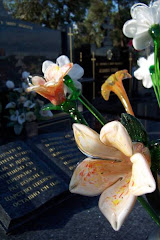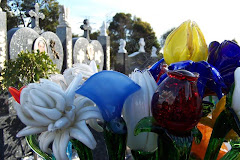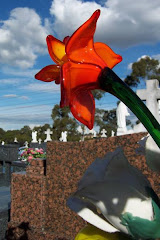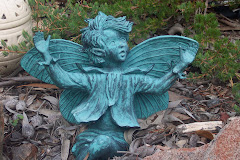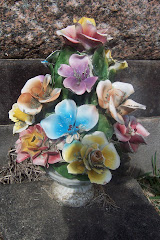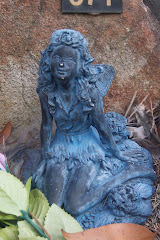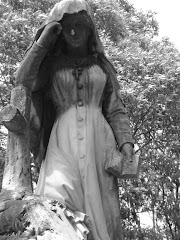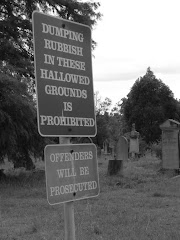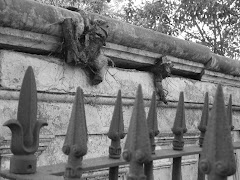I really need to go through my photographic collection systematically and write a little about each one I have visited. I aim to provide links to present and historical information, photographs, links to library resources, maps and other useful information. First one to be tackled is Camperdown Cemetery in Newtown.
Camperdown Cemetery History (so far)
About 18,000 people have been buried in the (once large) cemetery which was consecrated in 1849. Some of the old headstones were repositioned around the stone walls of the current cemetery. Burials ceased in the 1940s (Morgan, 1998)
There are a number of famous people buried there including
Sir Thomas Mitchell, the explorer and surveyor-general of NSW (Webster, 2007). Also
Eliza Donnithorne, who is believed to have been the inspiration for Miss Havisham in Great Expectations. An interesting story accompanies this lady. Apparently, "after her groom failed to turn up for their wedding breakfast, she left the breakfast on the table until the day she died. Charles Dickens heard about her from her neighbour, his friend Caroline Chisholm" (Webster, 2007). In December 2004 her grave headstone was smashed into 3 pieces. Peter Rodgers (then St Stephen's Anglican Church minister) requested funds to repair the headstone (and reinstate the original gates). The Newtown community came out to assist, ""We've received support from dog walkers, the gothic community, local residents coming in and people ringing up from all over the place...We also got funding from the Dickens Society." (The Glebe, 2004). The grave was repaired by The National Trust of Australia, Rookwood Anglican Cemetery and students from TAFE students as part of their monumental repair and maintenance course (The Glebe, 2004).
However, the famous shared the space with the less well known. One plaque reads: "In memory of the many humble, undistinguished, unknown, unremembered folk buried in this cemetery whose names are not written in the book of history, but are written in the book of life." (Webster, 2007) The cemetery is also home to 22 of the passengers aboard the
Dunbar, the ship that
sank off South Head in 1857 on a return voyage from England, killing 121 passengers. A
special altar contains the remains.
There are also reports of ghosts in the cemetery; two in particular. "Bathsheba Ghost", a matron of the Sydney Infirmary, was buried there in 1868. Some locals also believe the wife of Sydney harbourmaster Thomas Watson - after whom Watson's Bay is named - occupies corner of the graveyard in search of her lover (Morgan, 1998)
After a murder in 1946, much of the original 4.8 hectare cemetery was turned into a public park. Four acres were set aside for the cemetery and the headstones from the park were relocated.
"What most people don't know," says Ms Ward, "is they didn't move the bodies, they just moved the headstones. Throughout Camperdown Memorial Park the bodies are still there under the park." (SMH, October 6, 2007) Books The darker side of Newtown and surrounds : a self guided tour for the misguided / National Trust of Australia
Self guided tour of Camperdown Cemetery / Camperdown Cemetery Trust
Historic Camperdown / by the Rev. T. G. Rees.
Online Articles
It was murder and mayhem in old Newtown
Websites
Camperdown Cemetery (Sydney Distance Education High School in conjunction with Camperdown Cemetery Trust)
Camperdown Cemetery (Sydney Webcam)
Photographs
My photographs
Camperdown Cemetery Restoration ProjectOld Historical Camperdown Cemetery 1 (State Library of Victoria)Old Historical Camperdown Cemetery 2 (State Library of Victoria)Old Historical Camperdown Cemetery 3 (State Library of Victoria)Old Historical Camperdown Cemetery 4 (State Library of Victoria)St Stephen's Church - Camperdown Cemetery (State Library of Victoria)Plaque to the humble residents (Sydney Distance Education High School)
References
Morgan, J (1998) " Lay A Ghost As You Picnic",
Sydney Morning Herald, 17 October 1998. Retrieved, April 20, 2008 from Factiva Database.
Sydney Distance Education High School (2003) Camperdown Cemetery. Retrieved April 20, 2008 from http://www.ssdec.nsw.edu.au/history/camperdown/
Webster, S (2007) "It's a grave grave world",
Sun Herald , 21 January 2007. Retrieved April 20, 2008 from Factiva Database.
Historic Grave Wrecked (2004)
The Glebe, 1 November 2004, Retrieved, April 20, 2008 from Factiva Database.
"It was mayhem and murder in old Newtown" (2007)
Sydney Morning Herald. Retrieved April 20, 2008 from http://www.smh.com.au/articles/2007/10/05/1191091364643.html















































